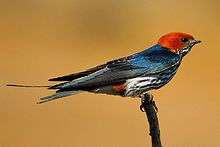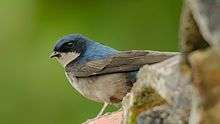Cecropis
| Cecropis | |
|---|---|
 | |
| Lesser striped swallow (Cecropis abyssinica) | |
| Scientific classification | |
| Kingdom: | Animalia |
| Phylum: | Chordata |
| Class: | Aves |
| Order: | Passeriformes |
| Family: | Hirundinidae |
| Subfamily: | Hirundininae |
| Genus: | Cecropis F. Boie, 1826 |
| Species | |
|
See text | |
| Synonyms | |
| |
Cecropis is a genus of large swallows found in Africa and tropical Asia. The red-rumped swallow's range also extends into southern Europe, and (in small numbers) into Australia. This genus is frequently subsumed into the larger genus Hirundo.[1]
The swallow family consists of 74 bird species which typically hunt insects in flight. The two river martins have long been recognised as very distinctive, and are placed in a separate subfamily, Pseudochelidoninae, leaving all other swallows and martins in the Hirundininae. DNA studies suggest that there are three major groupings within the Hirundininae subfamily, broadly correlating with the type of nest built.[2] The groups are the "core martins" including burrowing species like the sand martin, the "nest-adopters", with birds like the tree swallow which use natural cavities, and the "mud nest builders". The Cecropsis species construct a closed mud nest and therefore belong to the latter group. It is believed that the evolutionary sequence is from species that make open cup nests (Hirundo and Ptyonoprogne), through Delichon house martins with closed nests, to Cecropis and Petrochelidon, which have retort-like closed nests with an entrance tunnel.[3]
The genus Cecropis was introduced by the German zoologist Friedrich Boie in 1826.[4] The type species was subsequently designated as the greater striped swallow.[5] The name of the genus is from the Ancient Greek Kekropis "Athenian woman".[6]
Species
The nine species in the genus are:[7]
| Image | Scientific name | Common name | Distribution |
|---|---|---|---|
_(31008773580).jpg) | Cecropis cucullata | Greater striped swallow | southern Africa, mainly in South Africa, Namibia and southern Zimbabwe. It is migratory wintering further north in Angola, Tanzania and southern Democratic Republic of the Congo. |
 | Cecropis abyssinica | Lesser striped swallow | Sub-Saharan Africa from Sierra Leone and southern Sudan south into eastern South Africa. |
_(30987147586).jpg) | Cecropis semirufa | Red-breasted swallow | Sahara from the Eastern Cape north to northern Namibia and southern Angola in the west and Mozambique in the east, with a disjunct range from Senegal south to northern Angola east to Uganda, south western Kenya and north western Tanzania. |
 | Cecropis senegalensis | Mosque swallow | southern Mauritania and Senegal east to western South Sudan then south to Namibia, northern Botswana, Zimbabwe, Mozambique and north eastern South Africa. |
_Photograph_by_Shantanu_Kuveskar.jpg) | Cecropis daurica | Red-rumped swallow | Portugal and Spain to Japan, India, Sri Lanka and tropical Africa |
| Cecropis hyperythra | Sri Lanka swallow | Sri Lanka | |
 | Cecropis domicella | West African swallow | Senegal to eastern Sudan |
| Cecropis striolata | Striated swallow | South and Southeast Asia to northeastern India and Taiwan. | |
| Cecropis badia | Rufous-bellied swallow | Malay Peninsula. | |
References
- ↑ Angela K. Turner; Chris Rose (November 1989). Swallows & Martins: An Identification Guide and Handbook. Houghton Mifflin. ISBN 978-0-395-51174-9. Retrieved 16 February 2012.
- ↑ Sheldon, Frederick H.; Whittingham, Linda A.; Moyle, Robert G.; Slikas, Beth; Winkler, David W. (April 2005). "Phylogeny of swallows (Aves: Hirundinidae) estimated from nuclear and mitochondrial DNA". Molecular Phylogenetics and Evolution. 35 (1): 254–270. doi:10.1016/j.ympev.2004.11.008. PMID 15737595.
- ↑ Winkler, David W.; Sheldon, Frederick H. (June 1993). "Evolution of nest construction in swallows (Hirundinidae): a molecular phylogenetic perspective" (PDF). Proceedings of the National Academy of Sciences USA. 90 (12): 5705–5707. doi:10.1073/pnas.90.12.5705. PMC 46790. PMID 8516319. Archived from the original (PDF) on 2011-07-17.
- ↑ Boie, Friedrich (1826). "Generalübersicht". Isis von Oken (in German). 19. Col 971.
- ↑ Mayr, Ernst; Greenway, James C. Jr, eds. (1960). Check-list of Birds of the World. Volume 9. Cambridge, Massachusetts: Museum of Comparative Zoology. p. 113.
- ↑ Jobling, J.A. (2018). del Hoyo, J.; Elliott, A.; Sargatal, J.; Christie, D.A.; de Juana, E., eds. "Key to Scientific Names in Ornithology". Handbook of the Birds of the World Alive. Lynx Edicions. Retrieved 13 May 2018.
- ↑ Gill, Frank; Donsker, David, eds. (2018). "Swallows". World Bird List Version 8.1. International Ornithologists' Union. Retrieved 13 May 2018.